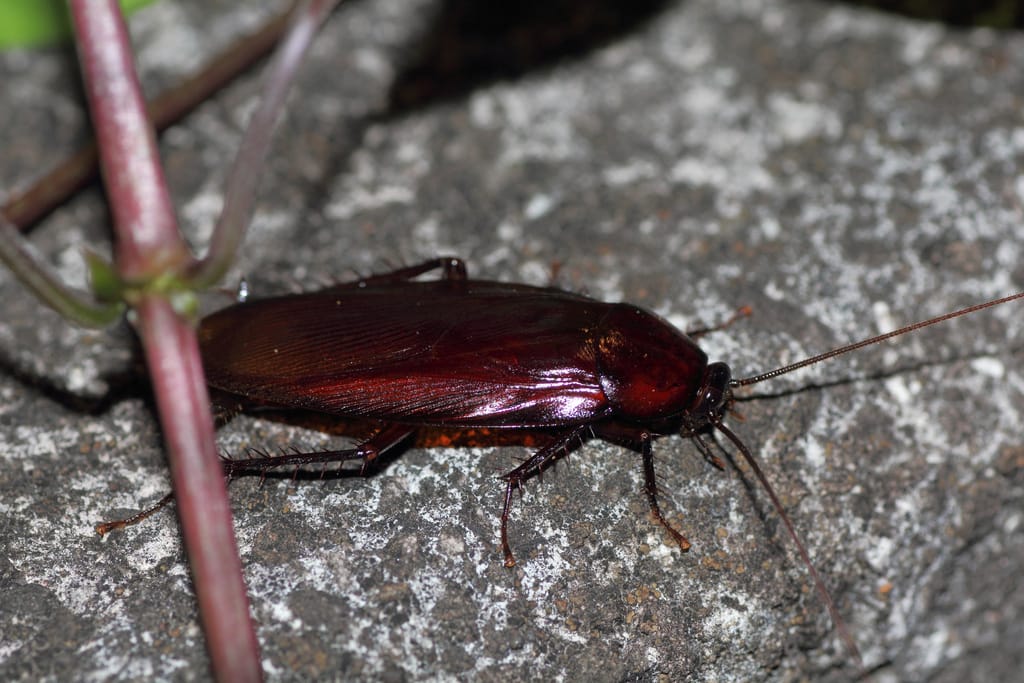The insect is a smokybrown cockroach. Read the following info to know how to identify and to control five types of cockroach found in Georgia!
This information is from the UGA publication, Management of Insect Pests in and Around the Home. The publication gives a full range of control options for 75 household pests based on pest biology. You will want to explore the entire publication, but this is an excerpt from the Cockroach Control section.
Cockroaches (Order Blattaria)
Cockroaches are large, night-active, fast-moving insects with a broad, flattened body, long antennae, and a relatively small head. The front pair of wings (called tegmina) are tough, protective, and lay on top of the membranous hind wings. Most cockroaches are poor fliers. None of the cockroach species listed below is indigenous to the U.S., but all are well established.
American cockroach (Blattidae: Periplaneta americana):
Adults are large (2 inches) with pale outer margins on the pronotum (upper thorax). Chestnut to light brown-colored insects that run quickly. Males and females are visually indistinguishable, although females are a little wider posteriorly than males.
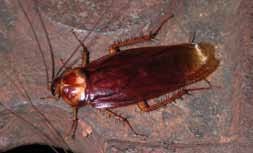
Habits:
Mainly found in sewers and other dark, damp hideaways such as basements. Rarely, if ever, found in attics. Night active. Sometimes found co-habiting outdoor harborage sites with smokybrown and/or Oriental cockroaches.
Interventions:
Apply gel baits (multiple small dabs no larger than a pea) or broadcast granular baits in areas where cockroaches are found. Bait stations can be used to control small nymphs, but adults and large nymphs may be too big to fit into the small openings in most bait stations.
Might Be Confused With:
Smokybrown cockroach, Oriental cockroach.
Smokybrown cockroach (Blattidae: Periplaneta fuliginosa):
Adults are large (1.5 inches) and uniformly dark cherry to dark red colored. Males and females are visually indistinguishable, although females are a little wider posteriorly than males. First instar nymphs approximately 1/8 to 3/16 inch, and identified by the white band across their back, just behind the thorax, and a white band on the tip of the antennae.
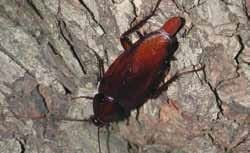
Habits:
Most common cockroach in suburban, Southern neighborhoods with mature hardwood trees present, where they commonly live in treeholes, attics, crawlspaces, sheds and similar harborages with high humidity and protected from the desiccating effects of wind. Not commonly found in kitchens, as is the German cockroach. Night active. Sometimes found co-habiting outdoor harborage sites with American and/or Oriental cockroaches. Rarely, if ever, found in sewers. First instars not very mobile; their presence suggests nearby egg case hatch.
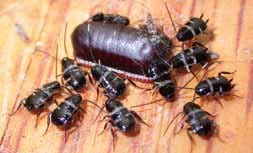
Interventions:
Apply gel baits (multiple small dabs no larger than a pea) or broadcast granular baits in areas where cockroaches are found. Bait stations can be used to control small nymphs, but adults and large nymphs may be too big to fit into the small openings in most bait stations.
Might Be Confused With:
American cockroach, Oriental cockroach.
Oriental cockroach (Blattidae: Blatta orientalis):
Adults are large (1 to 1.25 inches) and cherry to black colored. Males with short wings that do not completely cover the abdomen; females wingless (wingpads only).
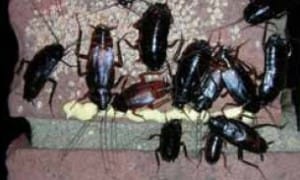
Habits:
Sometimes found cohabiting outdoor harborage sites with smokybrown and/or American cockroaches. Night active. Rarely found around homes in suburban environments. Biology and habits more similar to the American cockroach than the smokybrown cockroach.
Interventions:
Apply gel baits (multiple small dabs no larger than a pea) or broadcast granular baits in areas where cockroaches are found. Bait stations can be used to control small nymphs, but adults and large nymphs may be too big to fit into the small openings in most bait stations.
Might Be Confused With:
Smokybrown cockroach, American cockroach.
Asian cockroach (Blattellidae: Blattella asahinai):
Adults of both sexes about 1/2 to 5/8 inch, tan colored with dual, parallel stripes on back of pronotum (upper thorax). Males and females are visually indistinguishable.
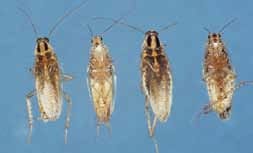
Habits:
Attracted to light, readily flies (rare for a cockroach), and found in shaded areas outdoors with leaf litter, mulch and/or high grass present. Rarely found indoors, unless attracted there by light. Flies during the day in response to disturbance (walking through habitat).
Interventions:
Alter lighting to make structure less attractive at night (see section in publication on Proactive Pest Management). Broadcast granular bait in areas where cockroaches are found. If desired, apply an appropriately labeled residual spray to those areas where cockroaches are found.
Might Be Confused With:
German cockroach.
German cockroach (Blattellidae: Blattella germanica):
Adults of both sexes about 1/2 to 5/8 inch, tan colored with dual, parallel stripes on back of pronotum (upper thorax). Males and females are visually indistinguishable.
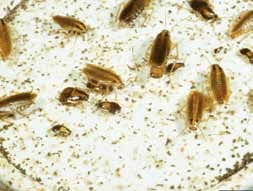
Habits:
Obligate indoor pest, never to rarely found outdoors except in cases of extreme indoor infestations. Found mainly in kitchens near and in warm appliances and sources of water. Night active. Under extreme levels of infestation this cockroach may be responsible for allergies, especially in children.
Interventions:
Use pheremone-based sticky traps to highlight areas of activity. Use gel baits and bait stations in areas (mainly in kitchen under the sink, next to the garbage, under/next to the refrigerator and stove, and in infested drawers) where German cockroaches are found. In moderate to heavy infestations, as many as 12-15 bait stations may be needed in a standard-sized home. Place bait stations on flat surfaces in corners and along edges of walls. When using gel baits, the application of many small bait ‘spots’ is preferred to the application of a few large bait spots (it does not take much bait to affect a large number of German cockroaches). If desired, in cases of extreme infestation apply a spot treatment with an appropriately labeled residual spray inside cracks and crevices where cockroaches are found. Total release aerosols (bug bombs) are ineffective at controlling German cockroaches, and should not be used indoors.
Might Be Confused With:
Asian cockroach.
About the Authors Daniel Suiter (dsuiter@uga.edu) and Brian Forschler (bfor@uga.edu) are Professors of Entomology, specializing in urban entomology, in the Department of Entomology at the University of Georgia; Suiter is located on the university’s campus in Griffin, while Forschler is on the main campus in Athens, GA. Lisa Ames (lames@uga.edu) directs the Homeowner Insect and Weed Diagnostics Laboratory on the UGA Griffin Campus. E. Richard Hoebeke, a systematic entomologist, is the associate curator of insects at the Georgia Museum of Natural History on the UGA’s main campus in Athens, GA (rhoebeke@uga.edu).
